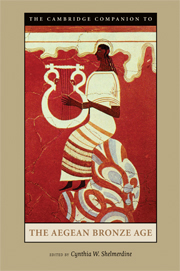Book contents
- Frontmatter
- 1 Background, Sources, and Methods
- 2 The Early Bronze Age in Greece
- 3 The Early Bronze Age in the Cyclades
- 4 Early Prepalatial Crete
- 5 Protopalatial Crete
- 6 The Material Culture of Neopalatial Crete
- 7 Minoan Culture: Religion, Burial Customs, and Administration
- 8 Minoan Crete and the Aegean Islands
- 9 Minoan Trade
- 10 Early Mycenaean Greece
- 11 Mycenaean Art and Architecture
- 12 Mycenaean States
- 13 Burial Customs and Religion
- 14 Mycenaean Greece, the Aegean and Beyond
- 15 Decline, Destruction, Aftermath
- Glossary
- Select Bibliography
- Index
- Plate section
15 - Decline, Destruction, Aftermath
Published online by Cambridge University Press: 28 November 2010
- Frontmatter
- 1 Background, Sources, and Methods
- 2 The Early Bronze Age in Greece
- 3 The Early Bronze Age in the Cyclades
- 4 Early Prepalatial Crete
- 5 Protopalatial Crete
- 6 The Material Culture of Neopalatial Crete
- 7 Minoan Culture: Religion, Burial Customs, and Administration
- 8 Minoan Crete and the Aegean Islands
- 9 Minoan Trade
- 10 Early Mycenaean Greece
- 11 Mycenaean Art and Architecture
- 12 Mycenaean States
- 13 Burial Customs and Religion
- 14 Mycenaean Greece, the Aegean and Beyond
- 15 Decline, Destruction, Aftermath
- Glossary
- Select Bibliography
- Index
- Plate section
Summary
Instability and Decline
At the end of LH IIIB2 - conventionally dated to ca. 1190 bce - the Mycenaean palatial period came to a dramatic end. The palaces were destroyed and the palace system collapsed, never to be rebuilt. The causes of the catastrophes have long been the subject of controversial scholarly discourse, and consensus is not in the offing. One thing, however, has become increasingly clear: the breakdown of the palace system was the result of a process that had started considerably earlier. It is generally assumed that the decline of the Mycenaean states was triggered by a first series of destructions at the end of LH IIIB1. At Mycenae several palace-related buildings outside of the citadel were destroyed and abandoned. At Tiryns the structures on the knoll below the palace (the Lower Citadel) were destroyed, and the palace of Thebes was also damaged. Nor were nonpalatial communities spared. Earthquakes have been blamed for the destructions at Mycenae and Tiryns. At other sites causes cannot be defined with certainty.
Whatever caused these earlier catastrophes, they seem to have brought to an end the heyday of the Mycenaean palace civilization. The archaeological record of the last decades of the thirteenth century bce (LH IIIB2) reflects instability and decline. Mycenae and Tiryns were damaged by further destruction, and the great citadel of Gla in Boeotia was burnt down and deserted, whereas other settlements were gradually abandoned. The Aegean islands also seem to have undergone a period of insecurity and change.
- Type
- Chapter
- Information
- The Cambridge Companion to the Aegean Bronze Age , pp. 387 - 416Publisher: Cambridge University PressPrint publication year: 2008
- 22
- Cited by

